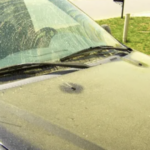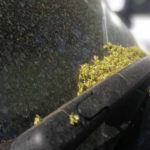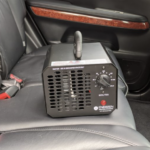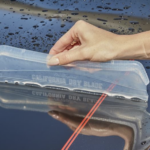What is a Ceramic Coating and How Does it Work?
Ceramic coatings have become one of the most effective ways to protect a vehicle’s paint. Unlike wax or sealants, which provide temporary protection, ceramic coatings bond to the surface, creating a durable, hydrophobic layer that repels water, dirt, and contaminants.
Made from silicon dioxide (SiO2), the coating chemically bonds with the clear coat, forming a strong, protective barrier. This layer prevents oxidation, UV damage, and chemical etching from bird droppings, tree sap, and hard water. Once applied, the coating enhances the paint’s gloss and depth while making maintenance easier.
How Ceramic Coating Differs from Wax and Sealants
Many car owners assume that wax provides enough protection. While wax and sealants add a layer of shine, they wear off quickly due to heat, rain, and washing. Ceramic coatings last significantly longer, with durability ranging from two to five years, depending on the product and maintenance.
A traditional wax application may last a few weeks to a couple of months before requiring reapplication. Synthetic sealants offer slightly longer protection, but they still degrade within six months to a year. Ceramic coatings, however, create a semi-permanent bond with the paint, eliminating the need for frequent reapplications.
Unlike wax, which melts at high temperatures, ceramic coatings withstand extreme heat, making them ideal for Florida’s intense sun. Their hydrophobic properties also prevent dirt, water, and road grime from sticking to the surface, reducing the need for frequent washing.
The Benefits of Ceramic Coating for Long-Term Protection
1. UV and Oxidation Resistance
Exposure to sunlight causes oxidation, leading to faded, dull paint. Ceramic coatings block UV rays, preventing oxidation and maintaining the vehicle’s color and shine for years. Cars frequently parked outside benefit the most from this type of protection.
2. Hydrophobic Properties for Easier Cleaning
One of the standout features of ceramic coatings is their ability to repel water. The slick surface allows rain to bead up and roll off, taking dirt and contaminants with it. This makes washing faster and reduces the likelihood of water spots forming on the paint.
3. Protection Against Chemical Stains
Bird droppings, tree sap, and bug splatter contain acidic compounds that can damage a car’s clear coat if not removed quickly. A ceramic coating provides a protective barrier, preventing these contaminants from bonding to the surface.
4. Enhanced Gloss and Shine
A ceramic-coated vehicle has a deep, wet-look shine that enhances the paint’s color and depth. The added gloss keeps the car looking new and well-maintained, improving overall aesthetics.
5. Reduced Maintenance and Washing Frequency
Because ceramic coatings repel dirt and grime, vehicles stay cleaner for longer. Washing becomes less frequent and requires minimal effort, as contaminants don’t bond to the surface as easily. Many car owners find they can go weeks without needing a full wash.
How Ceramic Coating Saves Money Over Time
Although ceramic coatings require a higher initial investment, they save money in the long run. Regular waxing and paint correction services add up over time, making ceramic coatings a cost-effective solution.
A vehicle that receives professional wax applications two to three times a year may cost hundreds of dollars annually in maintenance. A ceramic coating, by comparison, lasts for years with minimal upkeep, eliminating the need for frequent detailing expenses.
Additionally, preserving the paint’s condition increases resale value. Vehicles with well-maintained, glossy paint command higher prices in the used car market, making ceramic coatings an investment that pays off when selling or trading in.
The Application Process: Professional vs. DIY Ceramic Coating
Applying ceramic coating requires careful surface preparation. The vehicle’s paint must be free of dirt, grease, and imperfections before application. This ensures the coating bonds correctly and provides maximum protection.
Professional Ceramic Coating Application
Detailing professionals use advanced products that offer better durability and longevity. The process typically includes:
- Thorough washing and decontamination to remove all surface contaminants.
- Clay bar treatment to smooth out any roughness in the paint.
- Paint correction and polishing to eliminate swirl marks or imperfections.
- Application of ceramic coating in layers, followed by curing time.
Professional-grade coatings often provide longer-lasting protection, with some formulas lasting five years or more.
DIY Ceramic Coating Kits
For those looking to apply ceramic coating at home, DIY kits are available. These kits contain consumer-grade formulas that are easier to apply but may not last as long as professional coatings.
While DIY applications can provide solid protection, they require precision and patience. Any streaks or uneven application can result in imperfections that need correction. Professional services ensure a flawless, even coat with superior durability.
Common Myths About Ceramic Coating
1. “Ceramic Coating Makes My Car Scratch-Proof”
Although ceramic coatings provide an extra layer of protection, they do not make a vehicle immune to scratches or rock chips. They help prevent minor swirl marks but do not replace the need for careful washing and maintenance.
2. “I’ll Never Have to Wash My Car Again”
A ceramic-coated vehicle still requires washing, but the process is much easier. Dirt and contaminants don’t bond to the surface as easily, meaning a simple rinse or foam wash is often enough to keep the car clean.
3. “Ceramic Coating Replaces Wax Completely”
While ceramic coatings last longer than wax, some owners still choose to apply a maintenance wax or ceramic booster spray for added gloss and slickness.
How to Maintain a Ceramic Coated Car
A ceramic coating significantly reduces maintenance, but proper care ensures it lasts as long as possible.
- Use pH-balanced car shampoo to avoid stripping the coating.
- Wash with a two-bucket method to prevent scratching.
- Avoid automatic car washes with brushes that may damage the coating.
- Apply a ceramic spray booster every few months to refresh hydrophobic properties.
Simple maintenance helps extend the life of the coating, keeping the car looking fresh for years.
Is Ceramic Coating Worth It for Your Car?
For car owners looking to reduce maintenance while keeping their vehicle’s paint in pristine condition, ceramic coating is one of the best long-term investments. The combination of UV protection, hydrophobic properties, and chemical resistance makes it an excellent choice for preserving a car’s value.
Vehicles that are exposed to harsh sunlight, frequent rain, or hard water benefit the most from ceramic coatings. Drivers who want to reduce the need for frequent washing, waxing, and paint correction also find ceramic coatings worthwhile.
Final Thoughts: Long-Term Paint Protection with Ceramic Coating
Ceramic coatings provide superior protection compared to traditional wax or sealants. They shield against environmental damage, enhance shine, and make cleaning easier, all while preserving a car’s appearance for years.
For those who value low-maintenance vehicle care and long-term cost savings, ceramic coating is a smart investment. Whether applied professionally or through a DIY kit, it offers one of the most effective ways to maintain a car’s showroom-quality finish.
Leave a Comment Cancel Comment
Book Orlando Mobile Detailing
Search
Latest Post
-
 The Cost of Neglect: Why Regular Aircraft Detailing Saves Money in the Long Run
February 14, 2025
The Cost of Neglect: Why Regular Aircraft Detailing Saves Money in the Long Run
February 14, 2025
-
 Why Car Washes Aren’t Enough to Combat Pollen Damage
February 13, 2025
Why Car Washes Aren’t Enough to Combat Pollen Damage
February 13, 2025
-
 Orlando’s Pollen Problem: When Is It the Worst and How It Affects Your Car
February 13, 2025
Orlando’s Pollen Problem: When Is It the Worst and How It Affects Your Car
February 13, 2025
-
 How Ozone Generators Eliminate Stubborn Car Odors in Orlando
February 12, 2025
How Ozone Generators Eliminate Stubborn Car Odors in Orlando
February 12, 2025
-
 Why a Water Blade and Chamois Beat Towels Every Time!
February 9, 2025
Why a Water Blade and Chamois Beat Towels Every Time!
February 9, 2025
